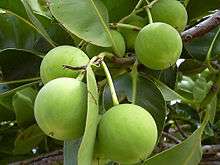Tamanu oil

Tamanu oil (also called beauty leaf oil, calophyllum inophyllum seed oil, calophyllum inophyllum oil, kamani oil, calophyllum oil, calophyllum inophyllum essential oil, dilo oil, foraha oil, Alexandrian laurel oil, poon oil, nyamplung oil, domba oil, honne oil (as biodiesel), undi oil, pinnai oil, fetau oil, punnai oil, daok oil, pinnay oil, kamanu oil, bitaog oil, tamanu nut oil, punna oil, takamaka oil (ambiguous), laurelwood oil (ambiguous), tacamahac oil (ambiguous), punnaga oil, fetaʻu oil, palo maria oil, ballnut tree oil, ballnut oil, btaches oil, beach calophyllum oil, or mù u oil) is pressed from nuts of either the Calophyllum inophyllum (usually) or the Calophyllum tacamahaca (ati) tree. The nuts yield 70–75% of the greenish-yellow inedible oil.[1] The oil originates in Polynesia, where it continues to play an important cultural role.[2] Commercial uses of tamanu oil are predominantly for skin care.
Chemical constituents
The oil contains the following fatty acids:
| Fatty acid | Content |
|---|---|
| Linoleic acid | 38% |
| Oleic acid | 34% |
| Stearic acid | 13% |
| Palmitic acid | 12% |
Other components include calophyllolide, friedelin, inophyllums B and P, terpenic essences, benzoic and oxibenzoic acids, phospho-amino lipids, glycerides, saturated fatty acids, and 4-phenylcoumarins.[3]
Usage
While tamanu oil has traditionally been used in skin care products, environmental pressures for renewable energy have created an ever-growing demand for biofuel in the form of biodiesel produced from vegetable oils – not just vegetable oils but inedible vegetable oils such as tamanu oil, rice bran oil, cotton seed oil, and others.(needs citation)
Scientific results to date suggest that engine performance is improved with a noticeable reduction in emissions for the chosen oils such as tamanu oil but without any engine modification. Present research work indicates that the biodiesel produced from tamanu oil is a potential alternative fuel. This is especially so for direct-injection four-stroke VCR engines. (needs citation)
The process by which tamanu oil can be used as biodiesel is called transesterification. This is a chemical reaction where glycerol is removed by transferring energy-storing hydrocarbon chains (called esters) from one alcohol molecule to another (typically methanol). The reason for this is that the glycerol tends to create deposits which cause problems with the normal operation of diesel engines.(needs citation)
This is not the first time tamanu oil has been used as a biofuel. During World War II, it was used as a biofuel to generate electricity to power radios. Traditionally, it has also been used as a fuel for lamps by lowering its naturally high viscosity to that of kerosene and can even be used as an alternative to kerosene in modified pressure stoves.(needs citation)
References
- ↑ Richmond, George P.; del Rosario, Mariano Vivencio (1907). "Commercial Utilization of some Philippine Oil-Bearing Seeds; Preliminary Paper". The Philippine journal of science (Philippines Bureau of Science) II: 444.
- ↑ D. Louppe; A.A. Oteng-Amoako; M. Brink, ed. (2008). Plant resources of tropical Africa 7. PROTA. p. 121. ISBN 90-5782-209-1.
- ↑ http://www.volcanicearth.com/access/CalophyllumInophyllum-TamanuOil.pdf
External links
- International Journal Of Energy and International Environmental Engineering
- Bogor Agricultural University Scientific Repository
- Impact of palm, mustard, waste cooking oil and Calophyllum inophyllum biofuels on performance and emission of CI engine
- Tamanu oil Botanical Data profile